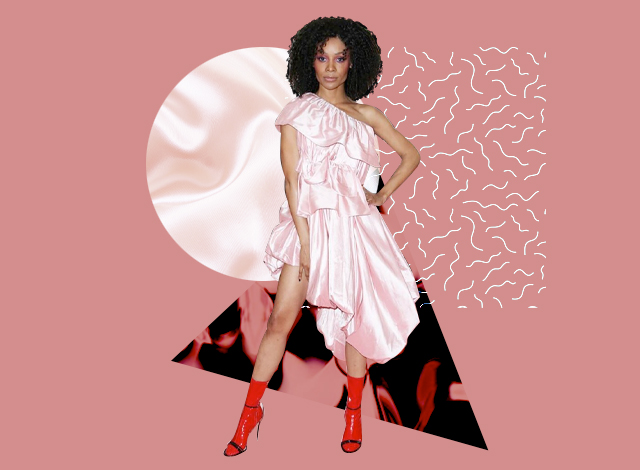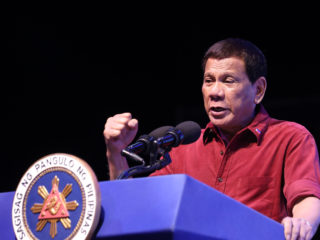
Filipino designer Puey Quiñones was pinching himself out of happiness after seeing E! News host Zuri Hall wearing his dress at the Met Gala 2019 pink carpet. “It’s my first Met Gala,” he tells us. “Her stylist contacted my PR and publicist in LA, and they presented my collection.”
Puey is based in Los Angeles. At the beginning of his career, he worked as designer Dennis Lustico’s assistant. He then started working for menswear brand Bergamo where he designed embroideries for the barong Tagalog. In 2002, socialite Ting Ting Cojuangco became his first client and Lulu Tan-Gan took him under her wing.
READ MORE: How Dennis Lustico, Rhett Eala, John Herrera, and Ivar Aseron are vamping up your basics online
The young designer’s career flourished in the early 2000’s, especially after he debuted a 30-piece collection (made from a local silk, koryo) in 2005 called “Swell.” He also started teaching gown and accessories-making at the New Bilibid maximum security prison in 2007. This eventually became the subject of the award-winning documentary, The World’s Most Fashionable Prison.
But Puey became more well-known for the wrong reasons after a “re-tagging scandal” in 2011. He admitted to using a department store-bought jacket and passing it off as his own. It was immediately tagged as a “fashion scam,” putting Puey’s name in a bad light for months. In an interview with Inquirer Lifestyle, he talked about losing clients and not being able to design new pieces after the incident.
Years later, Puey managed to get out of the slump and slowly made his mark in the US. He is currently the creative director of bridalwear brand Cocomelody, which opened its first pop-up in New York last March. Now, he’s gaining more traction after the Met Gala—even planning a comeback for his namesake line and rebuilding his clientele Manila despite his past controversy.
We asked Puey about his Met Gala debut, his future plans, and how he’s putting Filipino design on the map.
What was the concept of the design?
Design was inspired by Madame Grès 1969 monastic collection. The silhouette is based on the sleeves of her robe silk collection.
What was the reaction to the dress?
Honestly, it wasn’t my first choice. I was hoping she would wear the one I made that is more dramatic. But she opted to wear the simple one because she was going to be interviewing other guests. She loves the dress and the color fits the theme.
What kind of press does this give you? And as a designer trying to make a name in the US, how do you capitalize on this and build on momentum?
It actually opened doors for me. I just got a message from a stylist of a pop star asking me to collaborate for her concert tour this summer in the US. Also I am opening a showroom again in Manila soon and hopefully it will help me rebuild my name again in the industry.
What are the next steps for you to build awareness, steady clientele, and a following?
1. The next step for us is expansion. We just opened a store in New York for Cocomelody and opening more doors in the Asia Pacific region.
2. Understanding the market is very crucial in building a brand in a new country. You have to know what your market needs and let your market understand your brand as well.
3. For my own line, I want to establish my clientele again in Manila and rebuild my following.
Any plans on launching a new collection?
Yes, I am launching a new collection in LA soon. Supposedly last May 7 was my press launch but my dad passed away, so I had to go home and postpone my show. We are looking at July for my launch in LA.
How would you say your look and aesthetic have evolved?
I’m trying to balance the business of fashion. Bridal is the one supporting my passion. Making pink dresses is catering to a market. My aesthetic is still there for my own line but my color choices have evolved, I guess? I am more open to possibilities. I’m applying my personal life which is colorful to my designs now. And pink is actually fun! But honestly, at the end of the day, fashion is business. The brand has to sell. Aesthetic comes hand in hand with money-making.
What do you have to say to people who question your return, knowing your history? How would you address them since rebuilding your reputation is important to you?
I have already learned from my past and I would like to leave it behind. I have faced the consequences from my mistakes before and I believe in second chances like how I forgive people who wronged me. I have also learned the art of not giving a f*ck. As long as I am happy and not hurting anyone, then I know I am doing the right thing. I know reputation is very important, but it is also important to move on.
A lot of Filipino designers are choosing to focus on heritage—what it means to be a Filipino designer, highlighting Filipino elements or pursuing a Filipino sensibility. What does that mean to you today—as a Filipino designer pursuing a career abroad?
Frankly speaking, being a designer pursuing a career overseas doesn’t only mean showing elements of your designs and using Filipino materials. For me, being brave and being a proud Filipino, and standing for my color and ethnicity is the real essence of showing your heritage.
What are the greater challenges as a POC trying to make a name for himself? Has your race made it more challenging? And are there times when being a POC in this industry has been beneficial?
I am very fortunate that diversity in America is very well accepted and there’s a big movement now to really push POC in any field, especially in the fashion and entertainment industry. It’s our time to shine.
Art by Tricia Guevara
For the latest in culture, fashion, beauty, and celebrities, subscribe to our weekly newsletter here
Follow Preen on Facebook, Instagram, Twitter, YouTube, and Viber
Related stories:
The best definition of “Camp”: These Met Gala 2019 accessories
Male fashion icons at the Met Gala: People agree, androgyny is the future
These local designers are getting ready for a big trunkshow this week
Katy Perry changed into a burger costume at the Met Gala


